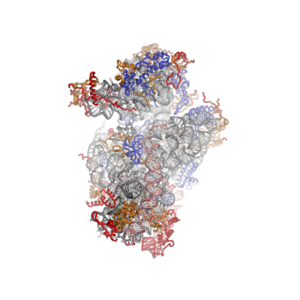Eukaryotic small ribosomal subunit (40S)
The eukaryotic small ribosomal subunit (40S) is the smaller subunit of the
However, the 40S subunit is much larger than the prokaryotic 30S subunit and contains many additional protein segments, as well as rRNA expansion segments.Function
The 40S subunit contains the decoding center which monitors the complementarity of tRNA and mRNA in protein translation. It is the largest component of several translation initiation complexes, including the 43S and 48S preinitiation complexes (PICs), being bound by several
Overall structure
The shape of the small subunit can be subdivided into two large segments, the head and the body. Characteristic features of the body include the left and right feet, the shoulder and the platform. The head features a pointed protrusion reminiscent of a bird's beak. The mRNA binds in the cleft between the head and the body, and there are three binding sites for tRNA, the A-site, P-site and E-site (see article on protein translation for details). The core of the 40S subunit is formed by the 18S ribosomal RNA (abbreviated 18S rRNA), which is homologous to the prokaryotic 16S rRNA. This rRNA core is decorated with dozens of proteins. In the figure "Crystal Structure of the Eukaryotic 40S Ribosomal Subunit from T. thermophila", the ribosomal RNA core is represented as a grey tube and expansion segments are shown in red. Proteins which have homologs in eukaryotes, archaea and bacteria are shown as blue ribbons. Proteins shared only between eukaryotes and archaea are shown as orange ribbons and proteins specific to eukaryotes are shown as red ribbons.
40S ribosomal proteins
The table "40S ribosomal proteins" shows the individual protein folds of the 40S subunit colored by conservation. Proteins which have homologs in eukaryotes, archaea and bacteria (EAB) are shown as blue ribbons. Proteins shared only between eukaryotes and archaea (EA) are shown as orange ribbons and proteins specific to eukaryotes (E) are shown as red ribbons. Eukaryote-specific extensions of conserved proteins, ranging from a few residues or loops to very long
| Structure (Eukaryotic)[9] | H. sapiens[8][10] | Universal name [11] | Conservation[12] | S. cerevisiae[13] | Bacterial homolog (E. coli) | Archaeal homolog |
|---|---|---|---|---|---|---|
 |
RPSA |
uS2 | EAB | S0 | S2p | S2 |
 |
RPS2 |
uS5 | EAB | S2 | S5p | S5p |
 |
RPS3 |
uS3 | EAB | S3 | S3p | S3p |
 |
RPS3A |
eS1 | EA | S1 | n/a | S3Ae |
 |
RPS4 ( RPS4Y2 ) |
eS4 | EA | S4 | n/a | S4e |
 |
RPS5 |
uS7 | EAB | S5 | S7p | S5p |
 |
RPS6 |
eS6 | EA | S6 | n/a | S6e |
 |
RPS7 |
eS7 | E | S7 | n/a | n/a |
 |
RPS8 |
eS8 | EA | S8 | n/a | S8e |
 |
RPS9 |
uS4 | EAB | S9 | S4p | S4p |
 |
RPS10 |
eS10 | E | S10 | n/a | n/a |
 |
RPS11 |
uS17 | EAB | S11 | S17p | S17p |
 |
RPS12 |
eS12 | E | S12 | n/a | n/a |
 |
RPS13 |
uS15 | EAB | S13 | S15p | S15p |
 |
RPS14 |
uS11 | EAB | S14 | S11p | S11p |
 |
RPS15 |
uS19 | EAB | S15 | S19p | S19p |
 |
RPS15A |
uS8 | EAB | S22 | S8p | S8p |
 |
RPS16 |
uS9 | EAB | S16 | S9p | S9p |
 |
RPS17 |
eS17 | EA | S17 | n/a | S17e |
 |
RPS18 |
uS13 | EAB | S18 | S13p | S13p |
 |
RPS19 |
eS19 | EA | S19 | n/a | S19e |
 |
RPS20 |
uS10 | EAB | S20 | S10p | S10p |
 |
RPS21 |
eS21 | E | S21 | n/a | n/a |
 |
RPS23 |
uS12 | EAB | S23 | S12p | S12p |
 |
RPS24 |
eS24 | EA | S24 | n/a | S24e |
 |
RPS25 |
eS25 | EA | S25 | n/a | S25e |
 |
RPS26 |
eS26 | EA | S26 | n/a | S26e |
 |
RPS27 |
eS27 | EA | S27 | n/a | S27e |
 |
RPS27A |
eS31 | EA | S31 | n/a | S27ae |
 |
RPS28 |
eS28 | EA | S28 | n/a | S28e |
 |
RPS29 |
uS14 | EAB | S29 | S14p | S14p |
 |
RPS30 |
eS30 | EA | S30 | n/a | S30e |
 |
RACK1 |
RACK1 | E | Asc1 | n/a | n/a |
See also
References
- ^ 40S+Ribosomal+Subunits at the U.S. National Library of Medicine Medical Subject Headings (MeSH)
- ^ S2CID 24771575.
- S2CID 9099683.
- S2CID 4419944.
- S2CID 4398636.
- S2CID 9201095.
- PMID 12212848.
- ^ PMID 14681386.
- ^ Structure of the 'T. thermophila,' proteins from the structures of the large subunit PDBS 417, 4A19 and small subunit PDB 2XZM
- ^ Nomenclature according to the ribosomal protein gene database, applies to H. sapiens and T. thermophila
- PMID 24524803.
- ^ EAB means conserved in eukaryotes, archaea and bacteria, EA means conserved in eukaryotes and archaea and E means eukaryote-specific protein
- ^ Traditionally, ribosomal proteins were named according to their apparent molecular weight in gel electrophoresis, leading to different names for homologous proteins from different organisms. The RPG offers a unified nomenclature for ribosomal protein genes based on homology.


